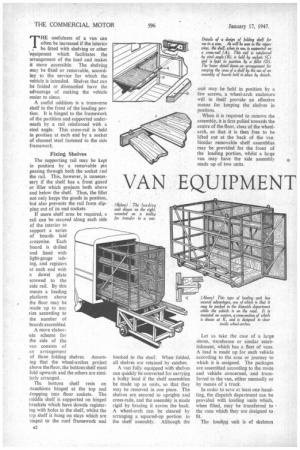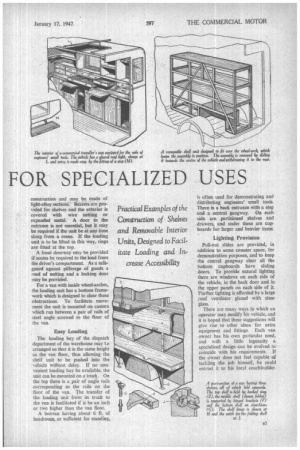VAN EQUIPMENT FOR SPECIALIZED USES
Page 36

Page 37

If you've noticed an error in this article please click here to report it so we can fix it.
Practical Examples of the Construction of Shelves and Removable Interior Units, Designed to Facilitate Loading and In
crease Accessibility
THE usefulness of a van can often be increased if the interior
. . be fitted with shelving or other equipment which facilitates the arrangement of the load and makes it more accessible. The shelving may be fixed or removable, according to the service for which the vehicle is intended. Shelves that can be folded or dismantled have the advantage of making the vehicle easier to clean.
A useful addition is a transverse shelf in the front of the loading portion. It is hinged to the framework of the partition and supported underneath by a rail reinforced with a steel angle. This cross-rail is held in position at each end by a socket of channel steel fastened to the side framework.
Fixing Shelves The supporting rail may be kept in position by a removable pin passing through both the socket end the rail. This, however, is unnecessary if the shelf has a front guard or fillet which projects both above and below the shelf. Thus, the fillet not only keeps the goods in position, but also prevents the rail from slipping out of its end sockets: If more shelf area be required, a rail can be secured along each side of the interior to support a series of boards laid crosswise. Each board is drilled and lined with light-gauge tubing, and registers at each end with a dowel plate screwed to the side rail. By this means a loading platform above the floor may be made up to any size according to the number of boards assembled.
A more elabor ate scheme for the side of the van consists of an arrangement of three folding shelves. Assuming that the wheel-arches project above the floor, the bottom shelf must fold upwards and the others are similarly arranged.
Thu bottom shelf rests on itanchions hinged at the top and .1ropping into floor sockets. The middle shelf is supported on hinged brackets which have dowels registering with holes in the shelf, whilst the
top shelf is hung on stays which are -tinged to the roof framework and
hooked to the shelf. When folded. all shelves are retained by catches.
A van fully equipped with shelves can quickly be converted for carrying a bulky load if the shelf assemblies be made up as units, so that they may be removed in one piece. The shelves are secured to uprights and cross-rails, and the assembly is made rigid by bracing it across the back. A wheel-arch can be cleared by arranging a squared-up portion in the shelf assembly. Although the unit may be held in position by a few screws, a wheel-arch enclosure will in itself provide an effective means for keeping the shelves in position.
When it is required to remove the assembly, it is first pulled towards the centre of the floor, clear of the wheelarch, so that it is then free to be lifted out at the back of the van. Similar removable shelf assemblies may be provided for the front of the loading portion, whilst a large van may have the side assembly made up of two units.
Let us take the case of a large stores, warehouse or similar establishment, which has a fleet of vans. A load is made up for each vehicle according to the area or journey to which it is assigned. The packages are assembled according to the route and vehicle concerned, and transferred to the van, either manually or by means of a truck.
In order to save at least one handling, the dispatch department can be provided with loading units which, when filled, may be transferred to the vans which they are designed to fit.
The loading unit is of skeleton
construction and may be made of light-alloy sections: Bearers are provided for shelves and the exterior is covered with wire netting or expanded metal. A door to the entrance is not essential, but it may be required if the unit be at any time slung from a crane. If the loadina unit is to be lifted in this way, rings are fitted at the top.
A front doorway may be provided if access be required to the load from the driver's compartment. As a safeguard against pilferage of goods a Toof of netting and a locking door may be provided.
For a van with inside wheel-arches, she loading unit has a bottom framework which is designed to clear these obstructions. To facilitate movement the unit is mounted on castors which run between a pair of rails of steel angle screwed to the floor of ..hc van.
Easy Loading The loading bay of the dispatch department of the warehouse may be arranged so that it is the same height as the van floor, thus allowing the sh-elf unit to be pushed into the vehicle without delay. If no convenient loading bay be available, the unit can be mounted on a truck. On the top there is a pair of angle mils corresponding to the rails on the floor of the van. The transfer of the loading unit from its truck to the van is facilitated if it be an inch or two higher than the van floor.
A boxvan having about 6 ft. of headroom, or sufficient for standing, is often used for demonstrating and distributing engineers' small tools. There is a back entrance with a step and a central gangway. On each side are partitioned shelves and drawers, and under these are cupboards for larger and heavier items.
Lighting Provision
Pull-out slides arc provided, in addition to some counter space, for demonstration purposes, and to keep the central gangway clear all the bottom cupboards have sliding doors. To provide natural lighting there are windows on each side of the vehicle, in the back door and in the upper panels on each side of it_ Further lighting is afforded by a large roof ventilator glazed with clear glass.
There are many ways in which an operator may modify his vehicle, and it is hoped that these suggestions will give riseto other ideas for extra equipment and fittings. Each van owner has his own particular need, and with a little ingenuity a specialized design can be evolved to
coincide with his requirements If the owner does not feel capable of tackling the job himself, he could entrust it to his local coachbuilder.












































































